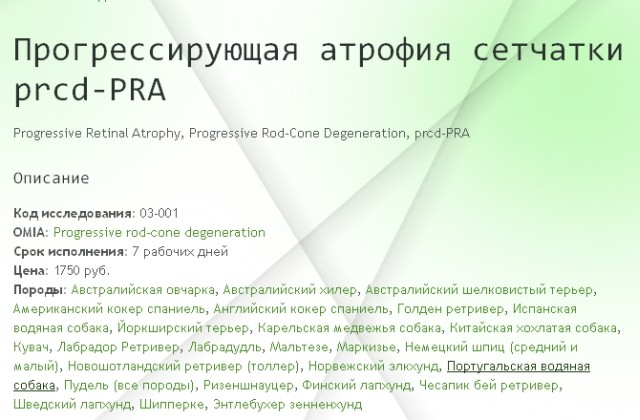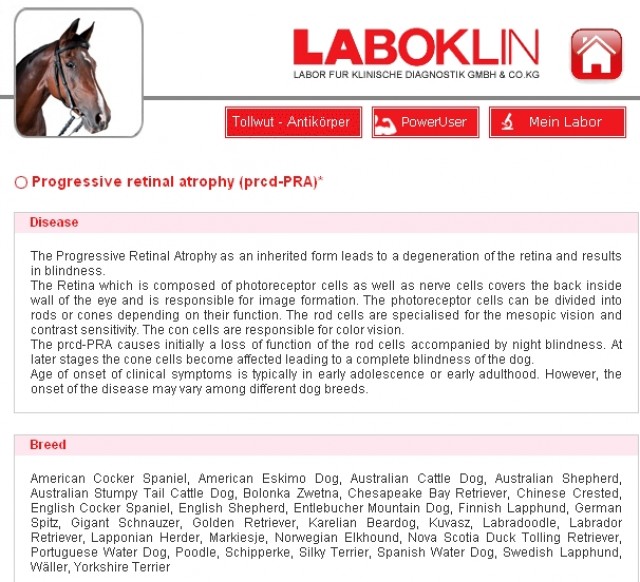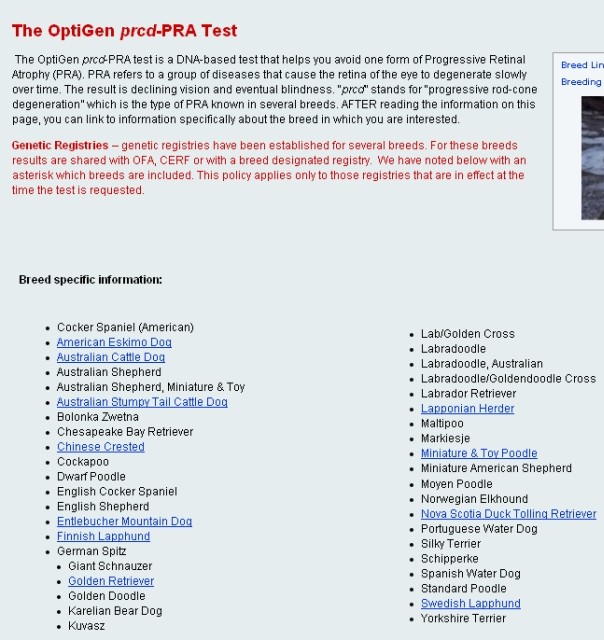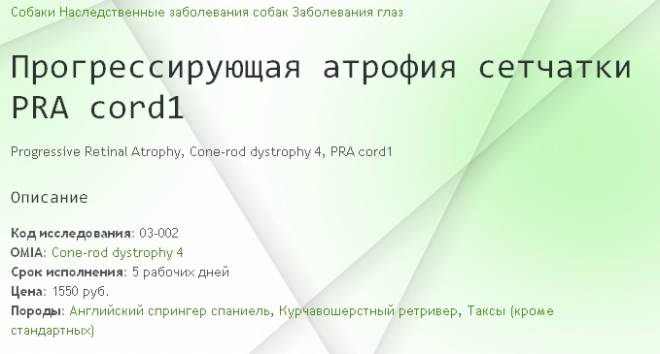KittyHello написал(а):Очень много ссылок на одну статью - и везде обтекаемо указано: "по материалам статьи WALTHAM FOCUS VOL 6 № 4 1996 «Аспеты наследственного заболевания глаз у породистой собаки» G.C.Bedford BVetMed, Ph.D, FRCVS, DVOphthal, DipECVO Королевский Ветеринарный Колледж, Великобритания"но оригинального текста к сожалению нет, есть только вот этот "типо перевод"
нашла оригинал на одном из форумов http://en.kinologysaratov.dogbb.ru/viewtopic.php?id=240
usually can atrophy crystals (PRA)
Pra applies to group diseases eye, under which cells of retina Palestinians, that leads to loss of of view.
In the early PRA affects ability to dogs to see in darkness, later dog can lose ability to to see and day.
--------------------------------------------------------------------------------
Needs remember, that NOT team with breed dogs, which not can be stunned - disease ceded and pomesnym and besporodnym-lover.
Tribal disease manifests itself at birth or can develop province in any age, but basis violations is shaped in the process organogeneza.
Should distinguish terms "the congenital" and "ancestral." The first applies to America’s failures, presented province in moment birth, and the latest - to any vice is, which is due genetically. So alone hereditary evils can reverberate already at birth, while other province not are manifest until early youth or even until more later periods life. Hence should, that many inbred evils development are not assets "inherited", but arise simply in a result be differentiation tissue fetus.
Usually can atrophy of retina (PRA)
History issue Line Progressive atrophy of retina (PRA) first time was is described in Sweden in 1906 year Dr. Magnussonom, as form of hereditary blindness. So as disease was revealed among setter, Oz-the Gordons English a view, then England and was recognized country his origin. To 30 st years it was called progressive an atrophied of retina, but until 50’s, about him little, that was known. In 50’s those involved in human bisected disease on two individual: Generalizovannuyu and central.
Currently disease marked by among such breeds, as the Norwegian elk hound, setter, Oz-gordon, the-a poodle, cocker-spaniel, Northern Samoyedic peoples, Yorkshire terrier breed, a giant the schnauzer, labrador and velsh-corgi.
That such PRA “PRA - ancestral vice development, under which is happening degeneration visual cells of retina eyes (sticks and conuses), that can lead to blindness. Disease manifests itself in violating functions photoreceptors of retina, svetochuvstvitelnogo perception the back wall eyes and falling conuses of view have dogs. Under term "atrophy" implies gradual thinning or loss of tissue of retina. As only process will affect the nerve the end of the, he will become irreversible, and restore vision check, will be impossible. ”
Pra is beginning to manifest itself on third-fifth s life dogs (on other data the most often PRA meets have dogs 5-7 years) and gradually leads to monitors early blindness dogs, offensive its stop impossible.
Expression of disease Here we go with losses a twilight of view (chicken blindness). Such dogs poorly geared in darkness, fear lie in dark room (disease vicious space), can bark on familiar objects, fear as well hop off now with bed.
With deteriorating of view dog in darkness can be confused direction movement, go utterly in other side. Are commemorated and other behavioral disorder.
Because blindness, caused PRA, overflows utterly painless, many owners not suspect about it, until disease not bashing too far. On least build-up atrophy sticks and conuses in the retina, all greater number of light rays reflectively is reflected from cover of an eye trawling (the most strongly expresses light layer in tissue vascular shell eyes, so-called tapetum lucidum). The retina is being eroded and dog gradually loses vision check. In late all comes blindness.
Dog Adjusts to it, compensating for vision check in other bodies feelings. That is why owner can view disease, to the same she not affects state of wool and eye color. Nevertheless, from-for enlarged pupil eye may seem very dark.
Forms PRA process two kinds of PRA: 1 / it or generalized - has affected the brink of retina, 2 / central (CPRA) --Attack center of retina.
Generalized PRA or simply PRA describes such degeneration, under which primary Balance disease is photoreceptor to. Such degeneration characterized chicken sightlessness, which has been unleashed until full blindness and promotes high frequency education secondary cataract. All these disease are inherited by on simple autosomal DNA retsessivnym lines. Under generalizovannoy atrophy, which has been unleashed more slowly, dog first poorly sees or not sees only in light, started and at night.
Central PRA (CPRA) represents a degeneratsiyu of retina, under which are struck by fotoretseptory, but she problem is secondary relative to distroficheskomu defektu in pigmentnom'cause the epithelials from of retina (Long). In the upstream CPRA was pereklassifitsirovana in a pigment car dystrophy...... of retina (RPED).
Have majority dogs CPRA manifests itself in age two-three years, and diagnosed, typically, to four years (after oftalmoskopicheskogo research). Under Decon eyes in the early disease discover brown pigment spills in surface of an eye trawling, and later - a very plaque.
Under central form disease in primarily of Iraqis central part of of retina, i.e. area best vision, so dog sees objects blurred, although ability to to see objects that move radially it persists. Peripheral vision check remains normal until endgame stage disease, thanks to what dogs see objects that move radially, modicum and find on fixed louvres. Moreover, dogs with CPRA poorly see objects on foreseeable distance. Unlike of radial forms, sick dogs better see in Sumerechnom light of, than under bright chrysoberyl.
Path of succession central and generalized forms differ and their ways of succession. Under CPRA he dominantno-autosomnyy (camping on E. Nestseplennyy with reproductive), likely, with incomplete penentratsiey gene - this means, that even under his available a sign of, for which he replies, can not adept. Range disease is in range Europe, that forces researchers to suspect rather impact on animals factors environmental or nutrition, than heredity. Dr. Aguirre reports, that "until now unpublished evidence from of England allow do conclusion, that cause of disease is lack of for antioxidants in food."
Precise hereditary degeneration of retina largely is unknown, but at least three type PRA were reported among running breeds Britain. Dysplasia photoreceptors sticks and conuses was first Liberty for Irish Setters (dysplasia sticks / conuses type I) and quite recently all areas fotoretseptora described have tsvergshnautsera. Have of last breed these signs of disease under oftalmoskopii can be not are visible to 5 th year life.
Recent research demonstrated, that genetic along is anomaly beta-subedinitsy fosfodiesterazy our generators and now perhaps predict disease and establish a dogs with normal phenotype. By relatively simple test on DNA.
Tests, based on DNA, will allow give precise analysis genotyping, forecast present disease and definition of Heterozygous carriers for retsessivno of inherited diseases.
Problems PRA in other countries
England
In early research way of succession this disease in of England mistakenly believed, that it stems with manifestation of simple the dominant gene with high, but full penentrantnostyo. Over time researchers discovered, that gene this recessive trait and if his had both a parent, then the percentage of birth blind hounds how sharply grew modestly, the rest same were piece disease.
The main difficulty diagnostics disease in of England was that those involved in human used for research blindness only at the. Dogs examined age one, two, three and four years. After passage first three tests them issued with a room a temporary certificate, and after fourth - permanent.
Unfortunately many dogs, have tolerated to equine breeding until achievements they 1 year age, to the same have dogs with permanent certificate often disease’s staunch defense later. Not all breeders osvidetelstvovali their dogs. Also in the time not all breeders and those involved in human understood hereditary nature of disease.
Currently in Britain information intends to and analyzed in the course joint projects veterinary doctors-as an with clubs fanciers in greater extent, than thanks to existing national projects collection information.
The US
In the US information about PRA was malodostupnoy, from-for what most breeders even not fine praise indeed about such a illness. The only way to to eradicate disease - this stop use in intended for breeding dogs - carriers anomalous gene, and for this their should reveal.
In America a series of clubs Star "Y encourages research in this area, receives certifications, confirmatory the absence of a recessive genes for little use dogs. Such a service registration eye diseases dogs (CERF) was is based in 1974. With 1989 this service combined with livestock medical bank data (VMDB) under University in West-Lafayette, Indiana -.
In the Brookings health animals James A. Baker College of veterinary medicine Cornell University state new York, under the leadership Gustavo D. Aguirre, is conducted work by definition and characterization various forms of PRA. This project is called "molecular-genetic study progressive degeneration sticks and conuses have dogs" (in Slovak - Prediction Genetic Studies of Canine Progressive Rod-Arts waypoint).
Finland
Before as use dog in plemennom intended for breeding make check-ups eye more 10 years. Of law and rules on compulsory check-ups there is no. This increasingly on choice noted. But all large nurseries their dogs inspect, camping on K. "launch" in herdbook work dog with such problem as PRA and obtain progeny with genetic disease - this "losing face" and obtain bad glory among breeders and owners. For collection information and waging statistics himself breeder reports in club at will.
Consignees calmed and males, and has presented to. The first check-ups make in year, then every two years check-ups repeat.
Conclusion L. J. S. Bedfor, chief state of on therapy and surgery small household animals Royal Veterinarnogo College of, London University of, Britain, writes:
“Prevention genetically specified diseases must become high priority in vosproizvodstve healthy dogs.
It is difficult occasionally nostrums, which was able would to eradicate nasleduemye disease, but there is no doubt, that usual check-ups eye, as part of registration policy any club-kennel could would foster change for the better.
A simple knowledge, that tribal disease there is, should spur the us attach the all efforts moreover, to future populations dogs were protected from constant threats.
Never cannot be to live with presence of seed inherited disease within breed. Rather this should stimulate us to the phenomenon potential threats and to cooperate on establish control for the spread of disease.
Currently precisely usual check-ups eye represents a the most effective way to control over underlying illness, and voluntary participation in it noted or club-kennel will bring all favor.
On materials
WALTHAM FOCUS VOL 6 № 4 1996
“Aspety inherited disease eye have porodistoy dogs ”
G.C.Bedford BVetMed, Ph.D, FRCVS, DVOphthal, DipECVO
Royal veterinary College, Britain
Отредактировано fishka (2016-08-15 09:16:45)







